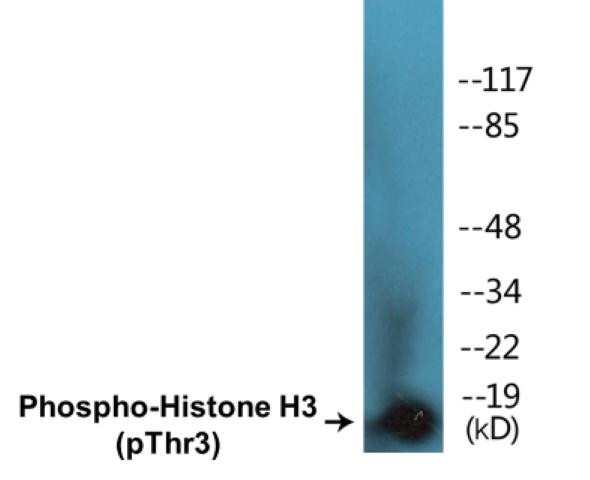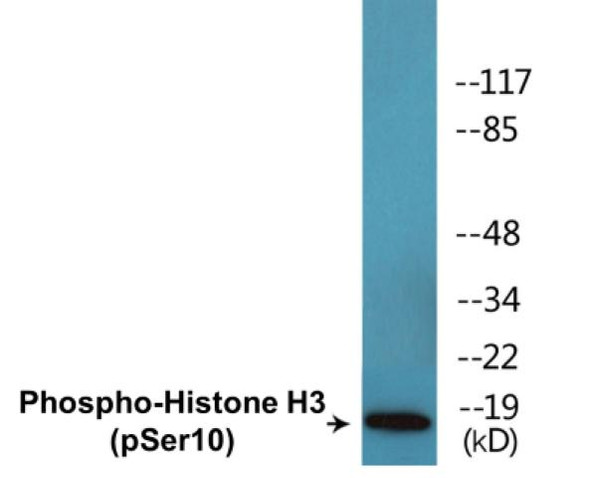Description
Histone H3 (Phospho-Ser28)Colorimetric Cell-Based ELISA Kit
The Histone H3 Phospho-Ser28 Colorimetric Cell-Based ELISA Kit is designed for the accurate detection of phosphorylated Ser28 on Histone H3 in cell lysates and tissue samples. This kit offers high sensitivity and specificity, ensuring reliable and reproducible results for researchers studying epigenetic modifications and gene expression regulation.Histone H3 is a key protein involved in chromatin structure and gene regulation, with phosphorylation of Ser28 playing a crucial role in regulating transcriptional activity. Dysregulation of this modification has been linked to various diseases, including cancer and neurological disorders, making the Histone H3 Phospho-Ser28 ELISA Kit an invaluable tool for understanding these conditions and developing potential therapies.
Overall, the Histone H3 Phospho-Ser28 Colorimetric Cell-Based ELISA Kit provides researchers with a reliable and convenient method for quantifying Histone H3 phosphorylation at Ser28, allowing for deeper insights into the molecular mechanisms underlying various physiological and pathological processes.
| Product Name: | Histone H3 (Phospho-Ser28) Colorimetric Cell-Based ELISA |
| Product Code: | CBCAB01274 |
| ELISA Type: | Cell-Based |
| Target: | Histone H3 (Phospho-Ser28) |
| Reactivity: | Human, Mouse, Rat |
| Dynamic Range: | > 5000 Cells |
| Detection Method: | Colorimetric 450 nm |
| Format: | 2 x 96-Well Microplates |
The Histone H3 (Phospho-Ser28) Colorimetric Cell-Based ELISA Kit is a convenient, lysate-free, high throughput and sensitive assay kit that can detect Histone H3 protein phosphorylation and expression profile in cells. The kit can be used for measuring the relative amounts of phosphorylated Histone H3 in cultured cells as well as screening for the effects that various treatments, inhibitors (ie. siRNA or chemicals), or activators have on Histone H3 phosphorylation.
Qualitative determination of Histone H3 (Phospho-Ser28) concentration is achieved by an indirect ELISA format. In essence, Histone H3 (Phospho-Ser28) is captured by Histone H3 (Phospho-Ser28)-specific primary (1ø) antibodies while the HRP-conjugated secondary (2ø) antibodies bind the Fc region of the 1ø antibody. Through this binding, the HRP enzyme conjugated to the 2ø antibody can catalyze a colorimetric reaction upon substrate addition. Due to the qualitative nature of the Cell-Based ELISA, multiple normalization methods are needed:
| 1. | A monoclonal antibody specific for human GAPDH is included to serve as an internal positive control in normalizing the target absorbance values. |
| 2. | Following the colorimetric measurement of HRP activity via substrate addition, the Crystal Violet whole-cell staining method may be used to determine cell density. After staining, the results can be analysed by normalizing the absorbance values to cell amounts, by which the plating difference can be adjusted. |
| Database Information: | Gene ID: 8350/8351/8352/8353/8354/8355/8356/8357/8358/8968, UniProt ID: P68431/Q71DI3/P84243, OMIM: 602810/602811/602812/602813/602814/602815/602816/602817/602818/602819, Unigene: Hs.132854/Hs.247813/Hs.247814/Hs.248176/Hs.443021/Hs.484990/Hs.532144/Hs.533292/Hs.546315/Hs.586261/Hs.591778 |
| Gene Symbol: | HIST1H3A |
| Sub Type: | Phospho |
| UniProt Protein Function: | H3: Core component of nucleosome. Nucleosomes wrap and compact DNA into chromatin, limiting DNA accessibility to the cellular machineries which require DNA as a template. Histones thereby play a central role in transcription regulation, DNA repair, DNA replication and chromosomal stability. DNA accessibility is regulated via a complex set of post-translational modifications of histones, also called histone code, and nucleosome remodeling. The nucleosome is a histone octamer containing two molecules each of H2A, H2B, H3 and H4 assembled in one H3-H4 heterotetramer and two H2A-H2B heterodimers. The octamer wraps approximately 147 bp of DNA. Belongs to the histone H3 family. |
| UniProt Protein Details: | Protein type:DNA-binding Chromosomal Location of Human Ortholog: 6p22.2 Cellular Component: extracellular region; membrane; nuclear chromosome; nuclear chromosome, telomeric region; nucleoplasm; nucleosome; nucleus; protein complex Molecular Function:cadherin binding; histone binding; protein binding Biological Process: blood coagulation; cellular protein metabolic process; chromatin silencing at rDNA; DNA replication-dependent nucleosome assembly; establishment and/or maintenance of chromatin architecture; negative regulation of gene expression, epigenetic; nucleosome assembly; positive regulation of gene expression, epigenetic; protein heterotetramerization; RNA-mediated gene silencing; telomere organization and biogenesis |
| NCBI Summary: | Histones are basic nuclear proteins that are responsible for the nucleosome structure of the chromosomal fiber in eukaryotes. Two molecules of each of the four core histones (H2A, H2B, H3, and H4) form an octamer, around which approximately 146 bp of DNA is wrapped in repeating units, called nucleosomes. The linker histone, H1, interacts with linker DNA between nucleosomes and functions in the compaction of chromatin into higher order structures. This gene is intronless and encodes a replication-dependent histone that is a member of the histone H3 family. Transcripts from this gene lack polyA tails but instead contain a palindromic termination element. This gene is found in the small histone gene cluster on chromosome 6p22-p21.3. [provided by RefSeq, Aug 2015] |
| UniProt Code: | P68431 |
| NCBI GenInfo Identifier: | 55977055 |
| NCBI Gene ID: | 8357 |
| NCBI Accession: | P68431.2 |
| UniProt Secondary Accession: | P68431,P02295, P02296, P16106, Q6ISV8, Q6NWP8, Q6NWP9 Q6NXU4, Q71DJ3, Q93081, A0PJT7, A5PLR1, |
| UniProt Related Accession: | P68431 |
| Molecular Weight: | 15kDa |
| NCBI Full Name: | Histone H3.1 |
| NCBI Synonym Full Names: | histone cluster 1 H3 family member h |
| NCBI Official Symbol: | HIST1H3H |
| NCBI Official Synonym Symbols: | H3/k; H3FK; H3F1K |
| NCBI Protein Information: | histone H3.1 |
| UniProt Protein Name: | Histone H3.1 |
| UniProt Synonym Protein Names: | Histone H3/a; Histone H3/b; Histone H3/c; Histone H3/d; Histone H3/f; Histone H3/h; Histone H3/i; Histone H3/j; Histone H3/k; Histone H3/l |
| UniProt Gene Name: | HIST1H3A |
| Component | Quantity |
| 96-Well Cell Culture Clear-Bottom Microplate | 2 plates |
| 10X TBS | 24 mL |
| Quenching Buffer | 24 mL |
| Blocking Buffer | 50 mL |
| 15X Wash Buffer | 50 mL |
| Primary Antibody Diluent | 12 mL |
| 100x Anti-Phospho Target Antibody | 60 µL |
| 100x Anti-Target Antibody | 60 µL |
| Anti-GAPDH Antibody | 60 µL |
| HRP-Conjugated Anti-Rabbit IgG Antibody | 12 mL |
| HRP-Conjugated Anti-Mouse IgG Antibody | 12 mL |
| SDS Solution | 12 mL |
| Stop Solution | 24 mL |
| Ready-to-Use Substrate | 12 mL |
| Crystal Violet Solution | 12 mL |
| Adhesive Plate Seals | 2 seals |
The following materials and/or equipment are NOT provided in this kit but are necessary to successfully conduct the experiment:
- Microplate reader able to measure absorbance at 450 nm and/or 595 nm for Crystal Violet Cell Staining (Optional)
- Micropipettes with capability of measuring volumes ranging from 1 µL to 1 ml
- 37% formaldehyde (Sigma Cat# F-8775) or formaldehyde from other sources
- Squirt bottle, manifold dispenser, multichannel pipette reservoir or automated microplate washer
- Graph paper or computer software capable of generating or displaying logarithmic functions
- Absorbent papers or vacuum aspirator
- Test tubes or microfuge tubes capable of storing ≥1 ml
- Poly-L-Lysine (Sigma Cat# P4832 for suspension cells)
- Orbital shaker (optional)
- Deionized or sterile water
*Note: Protocols are specific to each batch/lot. For the correct instructions please follow the protocol included in your kit.
| Step | Procedure |
| 1. | Seed 200 µL of 20,000 adherent cells in culture medium in each well of a 96-well plate. The plates included in the kit are sterile and treated for cell culture. For suspension cells and loosely attached cells, coat the plates with 100 µL of 10 µg/ml Poly-L-Lysine (not included) to each well of a 96-well plate for 30 minutes at 37 °C prior to adding cells. |
| 2. | Incubate the cells for overnight at 37 °C, 5% CO2. |
| 3. | Treat the cells as desired. |
| 4. | Remove the cell culture medium and rinse with 200 µL of 1x TBS, twice. |
| 5. | Fix the cells by incubating with 100 µL of Fixing Solution for 20 minutes at room temperature. The 4% formaldehyde is used for adherent cells and 8% formaldehyde is used for suspension cells and loosely attached cells. |
| 6. | Remove the Fixing Solution and wash the plate 3 times with 200 µL 1x Wash Buffer for five minutes each time with gentle shaking on the orbital shaker. The plate can be stored at 4 °C for a week. |
| 7. | Add 100 µL of Quenching Buffer and incubate for 20 minutes at room temperature. |
| 8. | Wash the plate 3 times with 1x Wash Buffer for 5 minutes each time. |
| 9. | Add 200 µL of Blocking Buffer and incubate for 1 hour at room temperature. |
| 10. | Wash 3 times with 200 µL of 1x Wash Buffer for 5 minutes each time. |
| 11. | Add 50 µL of 1x primary antibodies Anti-Histone H3 (Phospho-Ser28) Antibody, Anti-Histone H3 Antibody and/or Anti-GAPDH Antibody) to the corresponding wells, cover with Parafilm and incubate for 16 hours (overnight) at 4 °C. If the target expression is known to be high, incubate for 2 hours at room temperature. |
| 12. | Wash 3 times with 200 µL of 1x Wash Buffer for 5 minutes each time. |
| 13. | Add 50 µL of 1x secondary antibodies (HRP-Conjugated AntiRabbit IgG Antibody or HRP-Conjugated Anti-Mouse IgG Antibody) to corresponding wells and incubate for 1.5 hours at room temperature. |
| 14. | Wash 3 times with 200 µL of 1x Wash Buffer for 5 minutes each time. |
| 15. | Add 50 µL of Ready-to-Use Substrate to each well and incubate for 30 minutes at room temperature in the dark. |
| 16. | Add 50 µL of Stop Solution to each well and read OD at 450 nm immediately using the microplate reader. |
(Additional Crystal Violet staining may be performed if desired – details of this may be found in the kit technical manual.)






